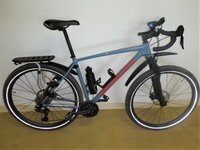My friend just bought an ebike with a 750wh battery. He says” the bigger the battery the better”. My opinion is that, besides my small regular battery, another small extra battery is better. That way I can have a fully charged battery always available, and if necessary I can bring the other partially charged battery along with me. I’m never concerned that the battery, I’m using, is getting too low to be useful if an unplanned longer ride comes up. That seems to bother my friend. He tries to keep his battery topped off all the time, just in case. He forgot, one night, woke up in the middle of the night, and in his pajamas, went into the night to charge up his battery. I’m wondering if other single big battery ebike riders have done the same. Ed
You are using an out of date browser. It may not display this or other websites correctly.
You should upgrade or use an alternative browser.
You should upgrade or use an alternative browser.
Two small ebike batteries vs one large battery.
- Thread starter EdC
- Start date
indianajo
Well-Known Member
My 840 wh battery far exceeds the ability of my hips to sit on the seat. I've tried 6 seats so far on this frame. Suspension posts will not fit my frame, nor will shaft clamp seats like cloud9. I do make sure my battery is charged before a 30 mile 3.7 hour (4.7 with a headwind) summer camp commute. I can charge at either end. The 1000 W DD motor consumed most of the charge on the route, red lighting on the 58th of 60 hills but working some more on the flatter end. The 1300 W geared hub motor would do the route in about 75% charge. The Mac12t motor would do the route in about 60% charge, faster than any other. On shorter trips, I don't charge until battery is below 45 v (48 v nominal, 53.6 max). I bought the 17.5 AH battery because I had desires of riding the bike to concerts & fairs 50 miles away, but my speed is about 9 mph when in shape and my pain endurance does not extend to that duration.
My battery is 4.2 years old and has about 350 charges. It is performing very well. It came from Luna. My battery is not quick change, and takes about 20 minutes, an 8" shaft phillips screwdriver, two 7/16" and one 11/32" combo wrenches, and a nail puller to get off. Two attempts have been made to steal it at the grocery store, both unsuccessful. A few nuts were backed off but not removed. The nuts resist the thief every turn. The battery enclosure was made by me out of aluminum angle, foam insulation, a plastic bag, and 20 screws with elastic stop nuts.
If I had a spare battery in the pannier, I would imagine it would be stolen at a concert venue 50 miles away. After all, the thief would know exactly when I was coming back, after the last encore of the final band. Plus a spent small battery couldn't be such a PIT* to take off.
My battery is 4.2 years old and has about 350 charges. It is performing very well. It came from Luna. My battery is not quick change, and takes about 20 minutes, an 8" shaft phillips screwdriver, two 7/16" and one 11/32" combo wrenches, and a nail puller to get off. Two attempts have been made to steal it at the grocery store, both unsuccessful. A few nuts were backed off but not removed. The nuts resist the thief every turn. The battery enclosure was made by me out of aluminum angle, foam insulation, a plastic bag, and 20 screws with elastic stop nuts.
If I had a spare battery in the pannier, I would imagine it would be stolen at a concert venue 50 miles away. After all, the thief would know exactly when I was coming back, after the last encore of the final band. Plus a spent small battery couldn't be such a PIT* to take off.
Last edited:
fooferdoggie
Well-Known Member
thats why you have to go faster so you can get farther before your butt falls off.
tomjasz
Well-Known Member
- Region
- USA
- City
- Minnesnowta
It's not about right or wrong or opinions. It's about what works for your ride. I have a bike with 25Ah. a BIG battery. It's my hauler workhorse. My run-a-quick-errand bike never gets ridden more than 5 -6 miles and a smaller lighter battery, on the lightest build possible, is ideal FOR ME. If I have several errands I grab a power tool battery for backup. Whatever works for the rider is the best choice.My opinion is that, besides my small regular battery, another small extra battery is better.
PedalUma
Well-Known Member
- Region
- USA
- City
- Petaluma, CA
I often do builds that can take more than one size of battery. In my opinion it allows for the greatest number of options. For example, taking one small battery for around town. Or, one larger battery for a 40 or 50 mile ride. Finally, taking one small and one larger battery in the bottom of a pannier if I want to ride until my butt goes numb and falls off.
Attachments
Bicyclista
Well-Known Member
I know the question is, "Which is better: one large battery or two small ones?" I will defer to the OP on his choice. However, for me, two batteries are better than one, and the larger the two batteries are the better. I ordered my Yuba Spicy Curry AT with two 500WH batteries. I wish it had been two 650WH batteries, but that was not an option.
I have two batteries for my 2016 Haibike. One is 400WH the other 500WH. To switch from one battery to the other I have to physically remove one and replace it with the other. In my 2022 Yuba, the two batteries are installed in the frame and there are electronics that control both (which is why the dealer charged me an extra $100 to install the additional electronics and additional battery). One battery will power the bike for 5 to 10% of the charge, then automatically switch to the other. The same thing happens during charging. A single charger will charge one battery for about 10% charge, then switch to the other battery for the next 10%, and so on until both batteries are fully charged and balanced. I use a timer to stop charging at about 80% and only fully charge about 3 or 4 times a year to balance the cells.
The good practice of charging to only 80% and to seldom discharge to less than 20% to extend battery life also argues for larger batteries. If you follow the good practice you are only using 60% of the capacity most of the time.
I have two batteries for my 2016 Haibike. One is 400WH the other 500WH. To switch from one battery to the other I have to physically remove one and replace it with the other. In my 2022 Yuba, the two batteries are installed in the frame and there are electronics that control both (which is why the dealer charged me an extra $100 to install the additional electronics and additional battery). One battery will power the bike for 5 to 10% of the charge, then automatically switch to the other. The same thing happens during charging. A single charger will charge one battery for about 10% charge, then switch to the other battery for the next 10%, and so on until both batteries are fully charged and balanced. I use a timer to stop charging at about 80% and only fully charge about 3 or 4 times a year to balance the cells.
The good practice of charging to only 80% and to seldom discharge to less than 20% to extend battery life also argues for larger batteries. If you follow the good practice you are only using 60% of the capacity most of the time.
harryS
Well-Known Member
I also prefer small batteries which are large enough for local rides. For something longer, I can carry spares too. or use a larger battery. Nonetheless, this is a easy matter for builders like Pedaluma or DIY ebikers like me. For commercial ebikes, it can be difficult to even get a spare or expensive to even get smaller batteries, much less find a way to carry them. If you're purchasing one bike, it's probably better just to have one battery and make it as large as possible.
.
But the way, I think your friend is safer not charging a battery when asleep. I never charge mine overnight.
.
But the way, I think your friend is safer not charging a battery when asleep. I never charge mine overnight.
Last edited:
Catalyzt
Well-Known Member
- Region
- USA
I'm thinking about this for my Trek kit bike. I basically have two bikes, the lightweight 40-pound Trek / Clean Republic kit for five-mile fitness rides (very steep hills here) and a 46-pound Motobecane with a medium-sized battery for 9 to 40 mile rides.
BUT I've abused the Trek battery, and will need another eventually, the range is already decreasing. If I got the upgraded battery, I'd have 20 miles of range, but would add five pounds. If I got a second battery, I'd have about 25 miles of range and only add three pounds... though the extra battery would fly around a lot in a backpack!
BUT I've abused the Trek battery, and will need another eventually, the range is already decreasing. If I got the upgraded battery, I'd have 20 miles of range, but would add five pounds. If I got a second battery, I'd have about 25 miles of range and only add three pounds... though the extra battery would fly around a lot in a backpack!
Stefan Mikes
Well-Known Member
- Region
- Europe
- City
- Mazovia, Poland
I own four 160 Wh Range Extender batteries for my Vado SL. The e-bike allows riding on the Range Extender only. For daily use, I rotate these small batteries to eventually equalize the number of charges between each of them and with the main 320 Wh battery. The weakness of riding on the small battery is it usually gets at the low charge level when you need assistance the most, for example to climb an overpass or a hill. On my adventure rides, I set the e-bike to equally discharge the main battery and the Range Extender. When both batteries become unusable because of low charge level, I simply connect yet another Range Extender. The benefit of SL system is you only carry Range Extenders when you need them.
I own three 604 Wh (nominal) batteries for my Vado 6.0. Because I have used each of them a lot, they are degraded to approximate charge of 500+ Wh each. As long as the planned ride distance (winter) does not exceed 40 miles (or 64 km), I take a single battery for a ride. (The summer range at low assistance could be 90 km). It could be one or two spare batteries depending on the ride distance at the cost of growing load of panniers. The most important is rotating the batteries for equal number of charges.
The nominal total charge of all my SL batteries is 960 Wh. The actual total charge of my U1-600 batteries is, say, 1500 Wh. I simply cannot imagine a single battery of combined capacity to be used on any of my e-bikes.
I own three 604 Wh (nominal) batteries for my Vado 6.0. Because I have used each of them a lot, they are degraded to approximate charge of 500+ Wh each. As long as the planned ride distance (winter) does not exceed 40 miles (or 64 km), I take a single battery for a ride. (The summer range at low assistance could be 90 km). It could be one or two spare batteries depending on the ride distance at the cost of growing load of panniers. The most important is rotating the batteries for equal number of charges.
The nominal total charge of all my SL batteries is 960 Wh. The actual total charge of my U1-600 batteries is, say, 1500 Wh. I simply cannot imagine a single battery of combined capacity to be used on any of my e-bikes.
6zfshdb
Well-Known Member
- Region
- USA
- City
- Northeast Pennsylvania
Another advantage to using multiple small batteries is weight distribution. They can be carried in a rack or frame bag, in panniers or a handlebar bag to better balance the bike. In general, they are also cheaper to replace.
On my 50 to 75 mile rides, my main 20AH battery isn't quite enough but carrying a second large battery is overkill. As others have mentioned. this is where carrying a small range extender battery is ideal.
I also don't like doing frequent partial charges on a large battery when I only use it for the last few miles of a ride. Whether or not it has any effect on battery health is debatable but it still shows up on my battery charge cycle counter.
On my 50 to 75 mile rides, my main 20AH battery isn't quite enough but carrying a second large battery is overkill. As others have mentioned. this is where carrying a small range extender battery is ideal.
I also don't like doing frequent partial charges on a large battery when I only use it for the last few miles of a ride. Whether or not it has any effect on battery health is debatable but it still shows up on my battery charge cycle counter.
Stefan Mikes
Well-Known Member
- Region
- Europe
- City
- Mazovia, Poland
Not sure how your specific system calculates the charges. On my system, "a full charge" happens only when the sum of partial recharges equals to the full battery capacity (-5%).Whether or not it has any effect on battery health is debatable but it still shows up on my battery charge cycle counter.
Similar threads
- Replies
- 17
- Views
- 2K
- Replies
- 23
- Views
- 3K
- Replies
- 15
- Views
- 4K




